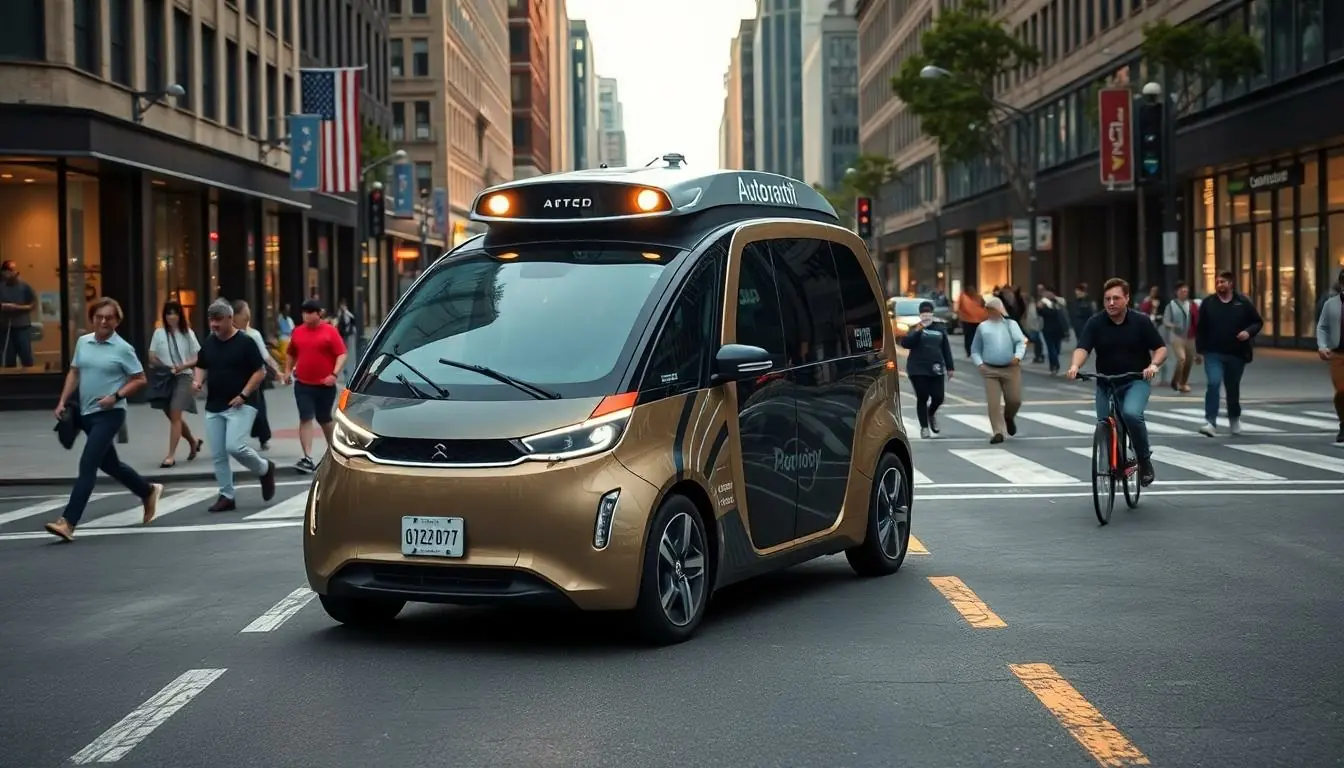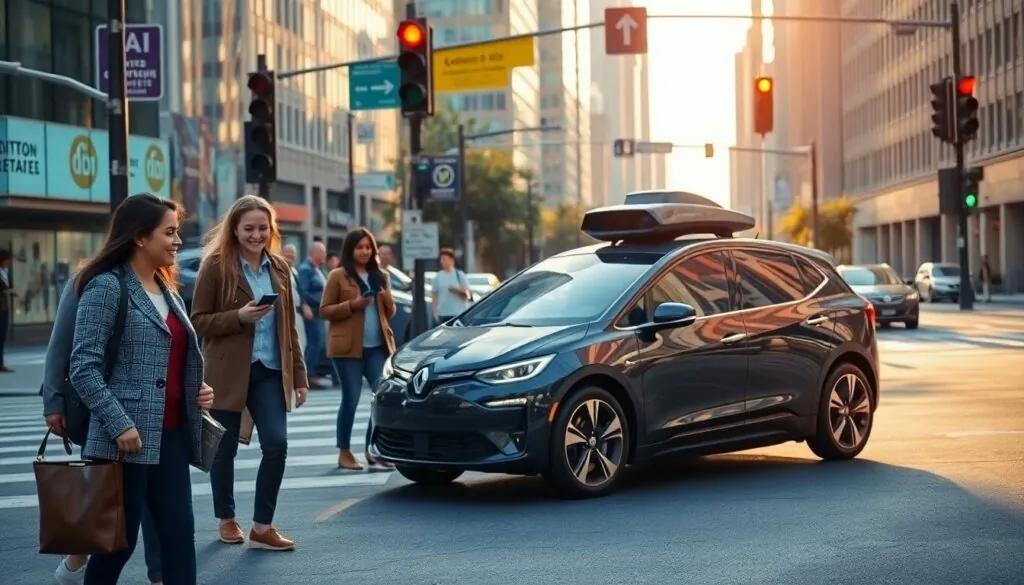Table of Contents
ToggleBuckle up, because artificial intelligence is revving its engines and taking the transportation world for a wild ride. Gone are the days of relying solely on human judgment; AI is here to navigate the roads, skies, and even the seas with precision and flair. Imagine a future where your car knows your favorite coffee shop better than you do—now that’s a game-changer!
From self-driving cars that make parallel parking look like child’s play to AI-powered traffic systems that reduce congestion faster than you can say “rush hour,” the possibilities are endless. It’s not just about convenience; it’s about safety, efficiency, and a dash of excitement. So, whether you’re a tech enthusiast or just someone who hates sitting in traffic, the impact of AI in transportation is something you won’t want to miss.
Overview of Artificial Intelligence in Transportation
Artificial intelligence significantly impacts transportation, shaping how people and goods move. AI enhances navigation through real-time data, allowing for efficient route planning. Systems equipped with AI can analyze traffic patterns, predicting congestion and improving travel times.
Self-driving vehicles exemplify AI’s transformative role. These vehicles use sensors and algorithms to navigate roads, adapt to changing conditions, and increase passenger safety. Moreover, companies implementing AI in fleets optimize fuel consumption, cut operational costs, and reduce emissions.
Traffic management systems leverage AI to analyze vast amounts of data from cameras and sensors. Such systems can adjust traffic lights dynamically, ensuring smoother flow in urban areas. Additionally, smart traffic signals communicate with connected vehicles, offering optimal route guidance and minimizing delays.
Predictive maintenance benefits from AI, leading to improved vehicle performance. By analyzing data from various vehicle components, AI can forecast potential failures and schedule timely maintenance. This proactive approach increases safety while reducing downtime.
AI also plays a vital role in logistics and supply chain management. Machine learning algorithms enhance demand forecasting, enabling companies to manage inventory better. Drones and autonomous delivery vehicles expedite last-mile deliveries, offering a seamless experience for consumers.
User experience in transportation services improves through AI-driven applications. Ride-sharing platforms use AI to match drivers with passengers efficiently while considering factors like location and time. These applications create a safer and more reliable service, enhancing customer satisfaction.
The integration of AI in public transportation shows measurable benefits. Smart buses equipped with AI systems can adapt schedules based on real-time demand. As AI technology continues to develop, its applications promise to reshape the transportation industry in further innovative ways.
Applications of Artificial Intelligence

Artificial intelligence (AI) revolutionizes various aspects of transportation, integrating advanced technologies to enhance efficiency and safety. Applications span across multiple domains, each transforming traditional methods into smarter systems.
Autonomous Vehicles
Autonomous vehicles utilize AI to navigate complex environments safely. They rely on sensors and cameras to interpret data, allowing for real-time decision-making. Various manufacturers are developing and testing these vehicles, aiming to reduce accidents and improve mobility for all. Safety metrics demonstrate a significant decrease in collision rates with the adoption of autonomous technologies, further showcasing their effectiveness.
Traffic Management Systems
Traffic management systems leverage AI to optimize traffic flow and reduce congestion. By analyzing data from various sources, these systems adapt traffic signal timings dynamically. Real-time monitoring enables adjustments that minimize delays, assisting drivers, cyclists, and pedestrians alike. AI applications in urban settings enhance overall transportation efficiency, contributing to lower emissions and improved air quality.
Predictive Maintenance
Predictive maintenance employs AI to anticipate vehicle issues before they occur. Advanced algorithms analyze historical data to forecast potential failures, ensuring timely interventions. Fleet operators benefit from reduced downtime and maintenance costs, as well-maintained vehicles perform optimally. Implementing such AI-driven strategies leads to increased reliability and efficiency in transportation operations.
Benefits of Implementing AI in Transportation
AI transforms transportation by enhancing safety, increasing efficiency, and reducing costs. These benefits significantly impact the industry and improve user experiences.
Enhanced Safety
Self-driving vehicles greatly reduce collision rates. Advanced sensors and AI algorithms analyze surroundings continuously, providing real-time responses to potential hazards. According to studies, autonomous vehicles demonstrate a 90% reduction in accidents compared to traditional vehicles. AI-enhanced systems also monitor driver behavior, alerting them to distractions or fatigue. Consistent monitoring ensures safer journeys for passengers and pedestrians alike. AI’s predictive capabilities forecast potential failures, allowing for timely maintenance, which further elevates safety standards.
Increased Efficiency
Traffic management systems utilizing AI optimize vehicle flow effectively. Such systems analyze data from sensors and cameras, adjusting traffic signals dynamically. Benefits include reduced congestion, which enhances travel times. AI-driven route planning solutions assist drivers in avoiding delays, efficiently guiding them through less congested paths. Smart public transportation adapts to real-time demand, ensuring buses and trains arrive on time. Autonomous delivery vehicles operate efficiently, coordinating schedules to expedite last-mile deliveries, thus maximizing resource allocation.
Cost Reduction
Implementing AI reduces operational expenses significantly for transportation providers. Predictive maintenance minimizes unexpected breakdowns, cutting repair costs and downtime. Fleet management systems leverage AI algorithms to optimize fuel usage, leading to lower fuel expenditures. Ride-sharing platforms effectively match drivers with passengers, maximizing vehicle utilization and reducing costs for users. Incorporating AI into logistics streamlines supply chain operations, leading to enhanced efficiency and reduced inventory costs. Overall, AI technology promotes substantial savings while elevating service levels in transportation.
Challenges and Considerations
Artificial intelligence in transportation presents various challenges and considerations that warrant attention to ensure its responsible implementation.
Ethical Concerns
Ethical concerns arise when deploying AI technologies in transportation. Autonomous vehicles must navigate moral dilemmas in critical situations, which raises questions about decision-making frameworks. Transparency in algorithms used for these decisions becomes crucial for public trust. Engagement with stakeholders is needed to address potential biases in AI training data that could lead to unfair treatment of certain populations. Continuous dialogue among developers, ethicists, and policymakers helps establish ethical guidelines shaping AI deployment.
Data Privacy Issues
Data privacy issues play a significant role in AI’s transportation applications. AI systems often rely on vast amounts of real-time data to optimize services, which can lead to concerns over user consent and data ownership. Regulation adherence ensures personal information is protected from breaches or misuse. Compliance with laws such as the General Data Protection Regulation (GDPR) contributes to maintaining user trust. Regular audits of data handling practices help organizations mitigate risks associated with data exposure.
Technical Limitations
Technical limitations impact the effectiveness of AI in transportation. Variability in sensor performance can hinder the reliability of self-driving cars, particularly in adverse weather conditions. Machine learning models require substantial training data to achieve accuracy, and limitations in data quality may affect outcomes. Compatibility with existing infrastructure presents another challenge, as older systems may not seamlessly integrate with advanced AI technologies. Investment in research and development is essential to address these technical obstacles and improve the resilience of AI applications.
Future Trends in Artificial Intelligence in Transportation
Artificial intelligence continues to redefine the transportation landscape, leading to several emerging trends. Autonomous vehicle technology shows significant advancements, enhancing safety through improved sensor capabilities and real-time hazard detection. Such vehicles are not just transforming passenger experiences but also optimizing fleet operations across logistics industries.
Electric vehicle integration with AI presents an opportunity for sustainable transportation solutions. AI algorithms can analyze energy consumption patterns, optimizing charging schedules and improving battery management systems for electric fleets. This trend leads to lower operational costs and reduced environmental impact.
Smart traffic management systems are gaining traction, utilizing AI to analyze vehicle flow and adjust traffic signals in real-time. This adaption decreases congestion significantly and improves overall road safety. Enhanced communication between vehicles and infrastructure promotes better traffic coordination, reducing unexpected delays.
Machine learning continues to improve demand forecasting in logistics. Retailers increasingly rely on AI to refine inventory levels and streamline last-mile delivery options, cutting operational costs and enhancing customer satisfaction. Drones and autonomous vehicles emerge as effective tools for accelerating these deliveries, paving the way for quicker response times.
Public transportation also benefits from AI advancements, with smart buses adjusting routes based on real-time passenger data. AI-driven applications allow for more effective scheduling, enhancing user experience through responsive services. As the focus on efficiency grows, cities leverage these technologies to create smarter, more sustainable urban environments.
Regulatory frameworks will evolve to ensure safe AI implementations while addressing ethical concerns. Establishing transparency in algorithms becomes crucial for building public trust in autonomous systems. The future of transportation promises innovative solutions that combine AI with sustainable practices, paving the way for a more connected and efficient world.
The integration of artificial intelligence in transportation is reshaping the industry in remarkable ways. Enhanced safety efficiency and cost reductions are just the beginning. As AI technologies advance they promise to address challenges like congestion and environmental impact while improving user experiences.
Future developments will likely focus on refining autonomous systems and smart traffic management. This evolution will require a balance between innovation and ethical considerations ensuring public trust and data privacy. With ongoing investment and research the transportation landscape will continue to evolve fostering a more connected efficient and sustainable future for all.




